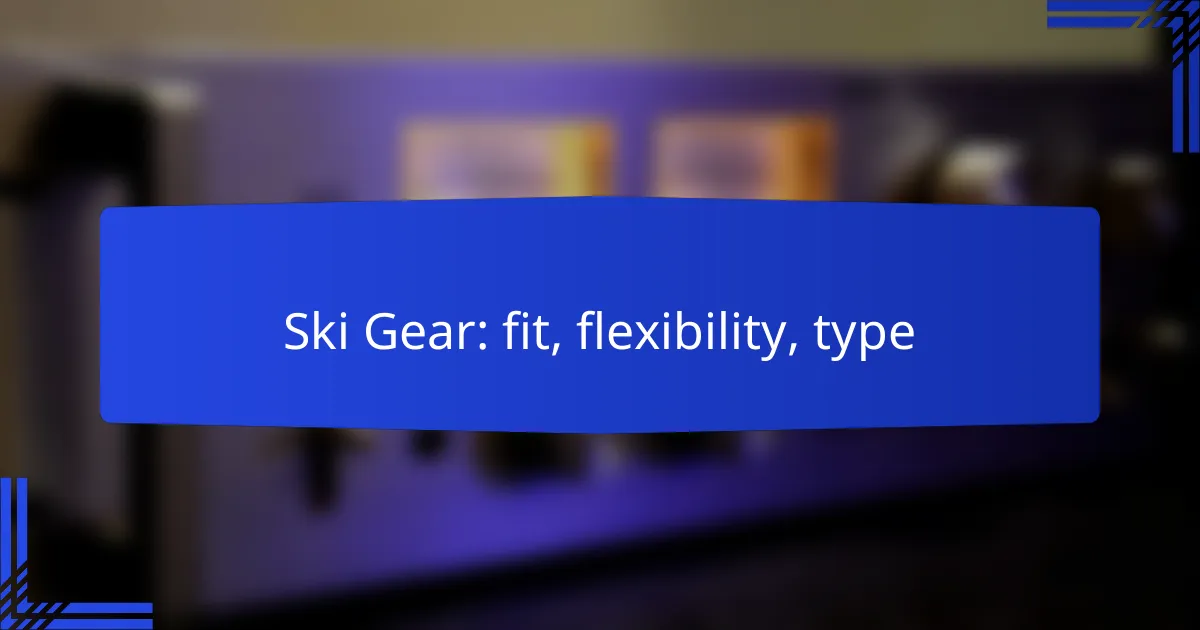Choosing the right ski gear is essential for maximizing performance and comfort on the slopes. Fitted ski jackets, custom-fit ski boots, and performance ski pants are crucial for adapting to the diverse weather and terrain, particularly in regions like New Zealand. Additionally, understanding the flexibility of your skis can greatly impact your ability to maneuver and respond to various conditions, making it important to select gear that aligns with your skiing style and needs.

What ski gear fits best for New Zealand conditions?
For skiing in New Zealand, the best gear includes fitted ski jackets, custom-fit ski boots, and performance ski pants. These items ensure comfort and flexibility while adapting to the varied weather and terrain found in the region.
Fitted ski jackets
Fitted ski jackets are essential for maintaining warmth and protection against the elements. Look for jackets that offer waterproofing and breathability, as New Zealand’s weather can change rapidly. A good fit allows for layering without being restrictive, enabling freedom of movement on the slopes.
Consider features like adjustable hoods, cuffs, and ventilation zippers to enhance comfort. Brands often provide options tailored to different body types, so trying on several styles can help find the perfect match.
Custom-fit ski boots
Custom-fit ski boots are crucial for maximizing performance and comfort while skiing. A proper fit reduces the risk of blisters and enhances control over your skis. Many ski shops in New Zealand offer boot fitting services, allowing for adjustments based on your foot shape and skiing style.
When selecting boots, prioritize flex ratings that match your skill level; softer boots are more forgiving for beginners, while stiffer options provide better responsiveness for advanced skiers. Always try on boots with the socks you plan to wear to ensure an accurate fit.
Performance ski pants
Performance ski pants should be both waterproof and breathable to handle New Zealand’s diverse skiing conditions. Look for pants with insulation for colder days and ventilation options for warmer weather. A good fit will allow for layering underneath without compromising mobility.
Features like reinforced knees and adjustable waistbands can enhance durability and comfort. When shopping, consider styles that offer a balance between protection and flexibility, ensuring you can move freely while navigating the slopes.

How does flexibility impact ski performance?
Flexibility significantly affects ski performance by influencing how well skis respond to terrain and skier input. A ski’s flex determines its ability to absorb shocks, turn effectively, and provide stability at various speeds.
Flex ratings explained
Flex ratings are numerical values that indicate how stiff or flexible a ski is, typically ranging from soft (around 60) to very stiff (over 100). Softer skis are easier to maneuver and are often preferred by beginners or those who enjoy a more playful style. In contrast, stiffer skis provide better edge control and stability at high speeds, making them suitable for advanced skiers.
These ratings can vary between manufacturers, so it’s essential to consider the intended use and personal skiing style when selecting skis. A good rule of thumb is to choose a flex rating that matches your skill level and the type of skiing you plan to do.
Benefits of flexible skis
Flexible skis offer several advantages, particularly for novice skiers or those who prefer a relaxed skiing style. They allow for easier turns and better maneuverability, which can enhance confidence on the slopes. Additionally, flexible skis tend to absorb bumps and irregularities in the snow, providing a smoother ride.
For park and freestyle skiing, flexibility is crucial as it enables tricks and jumps. Skiers can press, butter, and spin more easily with a softer flex. However, it’s essential to balance flexibility with the need for control, especially at higher speeds or on steeper terrain.

What types of ski gear are available?
There are several types of ski gear designed for different skiing styles and conditions. Each type of gear is tailored to enhance performance, safety, and comfort on the slopes.
Alpine ski gear
Alpine ski gear is specifically designed for downhill skiing on groomed trails. This category includes skis, ski boots, bindings, and poles that provide stability and control at high speeds.
When selecting alpine gear, consider your skill level and the type of terrain you will be skiing. Beginners may benefit from shorter, wider skis for easier maneuverability, while advanced skiers might prefer longer, narrower skis for better performance on steep slopes.
Freestyle ski equipment
Freestyle ski equipment is tailored for tricks, jumps, and terrain park features. This gear typically includes shorter skis with a twin-tip design, allowing for skiing both forwards and backwards.
When choosing freestyle gear, look for skis with a softer flex to enhance playfulness and maneuverability. Additionally, ensure that your boots provide adequate support while allowing for flexibility to execute tricks effectively.
Backcountry ski gear
Backcountry ski gear is designed for off-piste skiing and includes specialized skis, bindings, and skins for uphill travel. This equipment is essential for accessing remote areas where ski lifts are not available.
When selecting backcountry gear, prioritize lightweight options for easier climbing, and ensure your bindings are compatible with both alpine and touring boots. Always check local regulations regarding backcountry skiing to ensure safety and compliance.

What are the essential criteria for selecting ski gear?
When selecting ski gear, the key criteria include fit, flexibility, and type, all of which significantly impact performance and comfort on the slopes. Ensuring that your gear meets these criteria will enhance your skiing experience and help prevent injuries.
Material durability
Material durability is crucial for ski gear as it directly affects the lifespan and performance of your equipment. Look for materials that can withstand harsh weather conditions, abrasions from snow and ice, and the wear and tear of regular use. High-quality fabrics like Gore-Tex for jackets and reinforced materials for ski pants are excellent choices.
Additionally, consider the durability of ski boots and bindings. Boots should have sturdy shells and linings, while bindings should be made from robust metals or high-grade plastics to ensure they can handle the stresses of skiing. Regularly inspect your gear for signs of wear to maintain safety and performance.
Weight considerations
Weight is an important factor in ski gear, as lighter equipment can enhance mobility and reduce fatigue during long days on the slopes. However, it’s essential to balance weight with durability and performance; ultra-light materials may sacrifice strength. Aim for gear that offers a good compromise between weight and robustness.
For example, lightweight skis can improve maneuverability, but ensure they are designed for your skiing style and terrain. Similarly, choose ski boots that provide comfort without excessive bulk. Always try on gear and consider how it feels during movement to find the right balance for your needs.

How does ski gear vary by skill level?
Ski gear varies significantly by skill level, with different equipment designed to enhance performance and comfort for beginners, intermediates, and advanced skiers. Beginners typically need gear that is forgiving and easy to use, while advanced skiers benefit from equipment that offers precision and responsiveness.
Beginner ski gear recommendations
For beginners, the focus should be on comfort and ease of use. Soft-flex skis and boots are ideal, as they provide better control and stability while learning. Look for skis that are shorter in length, which can help with maneuverability.
Additionally, consider renting gear initially to find the right fit without a significant investment. Essential items include a good helmet, goggles, and waterproof clothing to ensure safety and comfort on the slopes.
Advanced ski equipment features
Advanced skiers should look for equipment that enhances performance, such as stiffer skis that provide better edge control and stability at high speeds. Features like adjustable bindings and lightweight materials can also improve responsiveness and reduce fatigue during long days on the mountain.
Investing in high-quality layers for insulation and moisture-wicking can make a significant difference in comfort. Advanced skiers may also benefit from specialized gear, such as backcountry equipment or racing skis, depending on their preferred skiing style.

What are the latest trends in ski gear technology?
The latest trends in ski gear technology focus on enhancing performance, safety, and sustainability. Innovations include smart gear that tracks performance metrics and eco-friendly materials that reduce environmental impact.
Smart ski gear innovations
Smart ski gear innovations integrate technology to improve the skiing experience. For example, some ski goggles now feature heads-up displays that provide real-time data on speed, altitude, and weather conditions. Additionally, wearable devices can monitor heart rate and fatigue levels, helping skiers manage their energy on the slopes.
When considering smart ski gear, look for features like GPS tracking and smartphone connectivity. These can enhance safety by allowing skiers to share their location with friends or family. However, be mindful of battery life, as many devices may require frequent charging during long ski days.
Eco-friendly ski equipment
Eco-friendly ski equipment is gaining popularity as skiers become more environmentally conscious. Brands are increasingly using sustainable materials such as recycled plastics and organic fibers in their products. This shift not only reduces waste but also appeals to consumers looking to minimize their carbon footprint.
When choosing eco-friendly gear, check for certifications like the Global Organic Textile Standard (GOTS) or the Global Recycle Standard (GRS). Additionally, consider brands that implement sustainable manufacturing practices. Investing in durable, high-quality gear can also contribute to sustainability by reducing the need for frequent replacements.

How can I maintain my ski gear for longevity?
To maintain your ski gear for longevity, regularly clean and inspect your equipment, store it properly, and perform necessary repairs. This proactive approach can significantly extend the lifespan of your gear and enhance your skiing experience.
Fit
Ensuring a proper fit for your ski gear is crucial for both performance and safety. Ski boots should fit snugly without causing discomfort, allowing for precise control. Consider visiting a professional fitter to assess your size and shape, as even minor adjustments can make a significant difference.
When selecting skis, look for a length that matches your height and skill level. Generally, shorter skis are easier to maneuver, while longer skis provide stability at high speeds. Always try before you buy, if possible, to ensure the best fit for your skiing style.
Flexibility
Flexibility in ski gear affects how well it performs under different conditions. Ski boots come in various flex ratings, which indicate how stiff or soft they are. Softer boots are more forgiving and easier for beginners, while stiffer boots provide better responsiveness for advanced skiers.
When selecting skis, consider the flex pattern as well. A softer flex is ideal for powder and playful skiing, while a stiffer flex is better for carving on groomed runs. Test different flex options to find what suits your skiing style and terrain preferences.
Type
Choosing the right type of ski gear is essential for optimizing your performance on the slopes. There are several categories of skis, including all-mountain, powder, and freestyle, each designed for specific conditions and styles. Assess your skiing habits to determine which type best meets your needs.
For ski boots, consider whether you prefer alpine, touring, or hybrid styles. Alpine boots are great for resort skiing, while touring boots offer versatility for backcountry adventures. Make sure to match your gear type with your skiing environment for the best experience.
